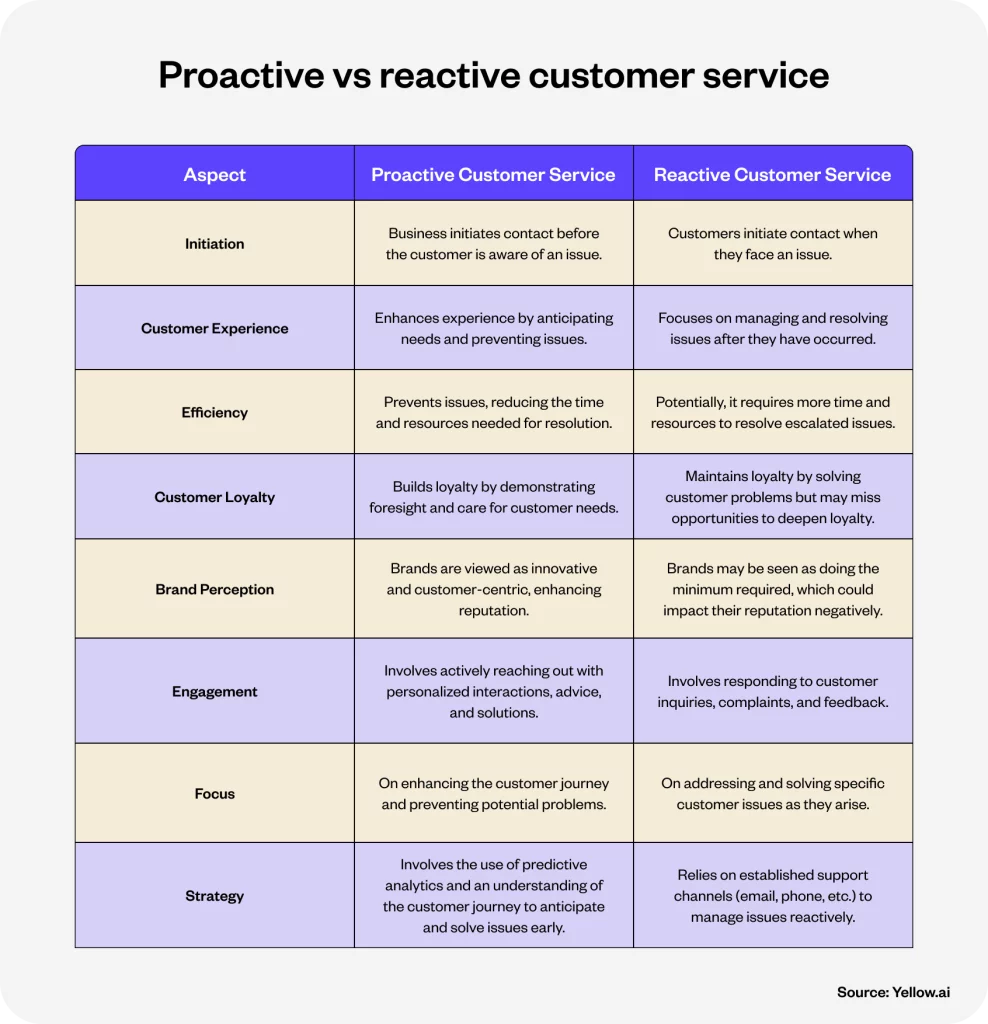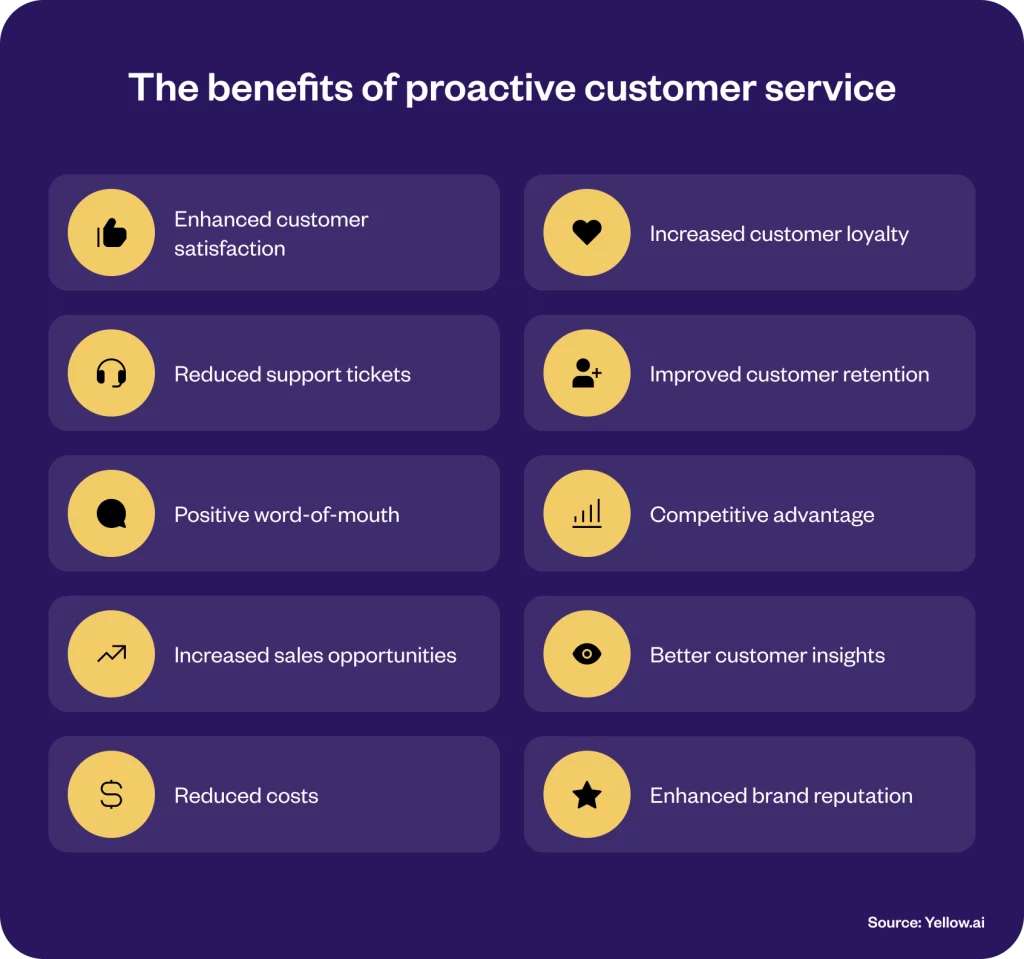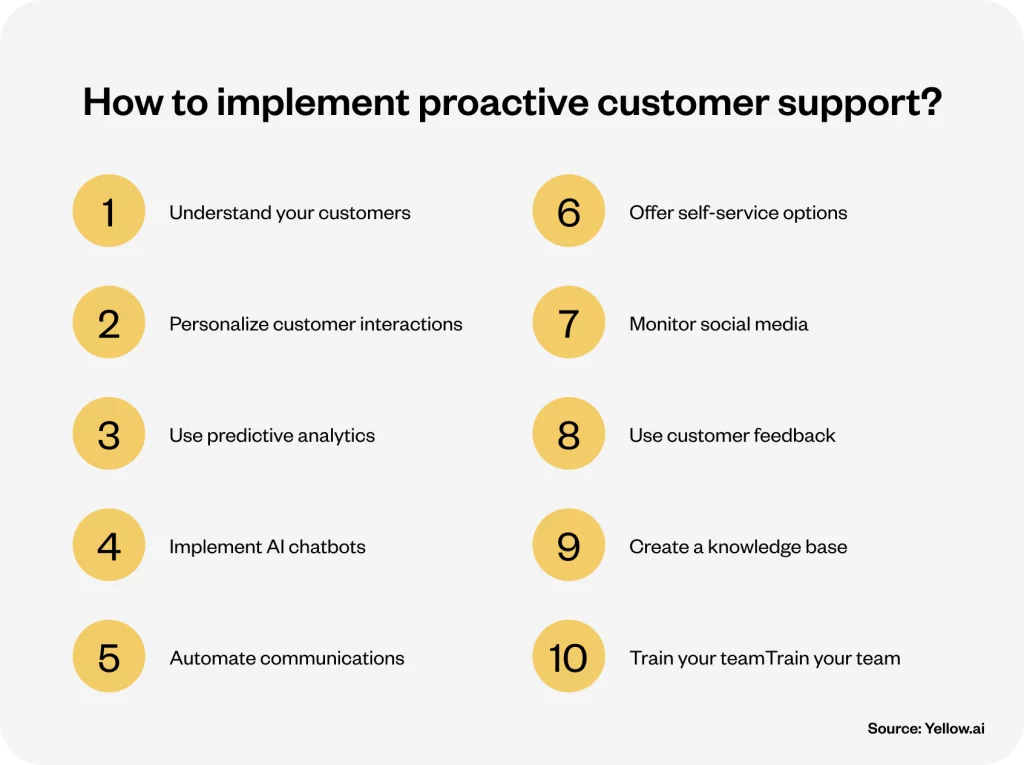In a rush and need the TL/DR version?
Summarize
Proactive customer service is a strategic approach where businesses anticipate and address customer needs before they surface. It enhances customer satisfaction, loyalty, and brand reputation by addressing issues before they escalate.
Here’s how businesses can implement proactive customer service:
- Understand your customers: Analyze customer data to predict and meet their needs.
- Personalize interactions: Use customer history to tailor communications and solutions.
- Employ predictive analytics: Predict potential issues and reach customers with solutions before encountering problems.
- Integrate AI chatbots: Provide 24/7 proactive responses to customer inquiries.
- Automate communications: Keep customers informed with automated updates and reminders.
- Provide self-service options: Empower customers with tools to resolve their issues.
- Monitor social media: Proactively respond to customer feedback and queries online.
- Leverage customer feedback: Use customer insights to improve service continuously.
- Create a knowledge base: Develop comprehensive resources for customers to find quick answers.
- Train your team: Equip staff with the skills to anticipate and address customer needs effectively.
Tools for proactive customer service include AI chatbots, predictive analytics tools, and customer feedback systems.
Note: This summary is not a substitute for reading the article in full, as you may miss out on important nuances.
Discover the transformative power of proactive customer service in this insightful exploration. Moving beyond traditional reactive measures, we explore strategies that anticipate and address customer needs before they arise. This blog explains the essence of proactive service, its benefits, and practical tips for businesses ready to enhance customer satisfaction, loyalty, and brand reputation.
Introduction
In a marketplace where trust is scarce yet crucial, proactive customer service emerges as a beacon of differentiation. The recent State of Consumer Data Privacy Survey reveals a stark reality: only 21% of consumers trust global brands with their personal information. This skepticism, fueled by rampant data breaches and privacy concerns, sets a challenging backdrop for businesses striving to build and maintain customer trust. Yet, within this challenge, proactive customer service finds its purpose and promise. It offers a proactive blueprint for earning back that trust, one anticipatory interaction at a time.
The stakes are sky-high, with 58% of consumers ready to cut ties over poor support experiences. This context makes a compelling case for a strategic overhaul, where businesses evolve from merely responding to actively anticipating customer needs. Gartner’s insights resonate here, indicating that proactive customer engagement can significantly boost crucial metrics like Net Promoter Score and Customer Satisfaction Score.
By weaving AI and predictive analytics into the fabric of customer service, businesses can transform support from a reactive chore to a proactive advantage. It is not limited to solving problems anymore. Instead, it is about foreseeing and addressing them before they even arise, turning potential obstacles into opportunities for loyalty and long-lasting relationships.
Related must-reads:
- Customer service automation – A full guide
- 10 Types of customer service you should know
- Customer service software: How to select the best one
- Good customer service: Ways to deliver [+10 Examples]
What is a proactive approach to customer service?
Proactive customer service is the strategic approach where businesses anticipate customer needs, questions, or issues before they arise. It is a forward-thinking methodology that empowers companies to reach out to customers with solutions and information before the customer realizes the need to ask. This model is rooted in the understanding that the best customer service is one that prevents problems before they happen, enhancing customer satisfaction and loyalty.
Proactive customer service is fundamentally about foreseeing potential questions or issues and addressing them ahead of time. It could be as straightforward as a restaurant’s waiter offering recommendations based on your preferences or as complex as an ecommerce platform using data analytics to provide personalized shopping advice. The core idea is to transition from a passive stance, waiting for customers to voice their concerns, to an active one where the business initiates the conversation. This shift is crucial in an era where 87% of US consumers have expressed a preference for companies that engage them proactively.
The significance of this service model cannot be overstated. In an era marked by immense competition and high customer expectations, being proactive is a way to stand out and foster deep loyalty. It signifies a brand’s commitment to exceeding customer expectations. For businesses, this means identifying potential friction points before they become problematic and also seizing opportunities to delight customers, offering personalized experiences that resonate and build trust. Through predictive analytics, AI, and a deep understanding of customer behavior, businesses can transform customer service from a cost center into a strategic asset that drives engagement, retention, and, ultimately, business growth.
Proactive vs reactive customer service
The essence of proactive and reactive customer service lies in who initiates the interaction. In a proactive model, businesses take the lead, reaching out to customers before issues arise or become apparent to them. This approach is just like watering your garden before the plants show signs of thirst. By doing so, you prevent problems before they impact the customer. On the other hand, reactive customer service waits for customers to raise issues or questions before responding. This traditional method can leave customers dealing with problems on their own until they reach out for help. It can potentially escalate their frustration and dissatisfaction.
Here is a breakdown of the differences between both approaches.

While proactive customer service offers numerous advantages, including increased satisfaction, loyalty, and operational efficiency, it’s not a standalone solution. The most successful businesses employ a hybrid approach, blending proactive strategies with a strong reactive support system. This combination ensures that while proactive efforts reduce the frequency and severity of issues, reactive support is available and effective when customers need it.
The 10 benefits of proactive customer service
Now that you know the foundational differences between proactive and reactive customer service, it’s vital to spotlight the benefits of a proactive approach. This strategic pivot enhances customer interaction and elevates customer satisfaction and loyalty to new heights. Here’s a closer look at how proactive customer service can significantly impact your business.

1. Enhanced customer satisfaction
When businesses anticipate and solve problems before customers are even aware of them, customer satisfaction skyrockets. This preemptive approach to customer service ensures that customers enjoy a seamless experience with your brand, free from the potential frustration of encountering and reporting issues. Imagine a scenario where an online streaming service notices a customer facing repeated buffering issues. Before the customer even reaches out, they are contacted with a solution or a workaround. This level of attentiveness significantly boosts customer satisfaction, as issues are resolved before they escalate into frustrations.
Related read: Customer satisfaction: Benefits, examples & how to measure
2. Increased customer loyalty
Besides just resolving issues, proactive customer service also builds more profound connections with customers. By showing that you value their time and experience enough to anticipate their needs, you foster a sense of loyalty that transcends transactional relationships. This loyalty is priceless in today’s competitive market. For instance, if a mobile carrier detects signal issues in a specific area, proactively informs affected customers of the problem, and takes steps to fix it, customers feel valued and cared for.
Related read: Customer Loyalty: Importance & Strategies to Increase
3. Reduced support tickets
By addressing issues before they escalate, proactive customer service significantly reduces the volume of support tickets. Besides easing the load on your customer service team, it also streamlines your operations. As a result, it allows for more efficient resource allocation. For instance, a software company releases an update that could potentially confuse users. The company can significantly reduce incoming support tickets by proactively sending out detailed guides and FAQs before questions arise. It will make operations more efficient.
Related read: Help desk ticketing system: Best practices for businesses
4. Improved customer retention
The proactive approach goes beyond solving immediate problems. It demonstrates to customers that their satisfaction and continued patronage are top priorities for your business. This commitment to their well-being is a powerful tool for customer retention. Consider a bank that proactively reaches out to customers with expiring credit cards, offering a simple, streamlined renewal process. This preemptive service minimizes inconvenience for the customer. It will enhance retention through a seamless experience.
Related read: How to retain customers: 15 strategies to improve customer retention
5. Positive word-of-mouth
Happy customers talk. Satisfied customers are more likely to share their positive experiences with others. Proactive customer service creates memorable moments that customers are eager to share. It effectively turns them into brand ambassadors. A proactive service experience, like a retailer reaching out to customers with product care tips immediately after purchase, can turn customers into enthusiastic brand advocates. These brand advocates will spread positive word-of-mouth.
6. Competitive advantage
In a landscape where many businesses still rely on reactive customer service, adopting a proactive approach sets you apart. This differentiation can be a crucial factor in winning over customers from competitors. A proactive approach, such as a utility company sending weather-related service alerts, distinguishes your brand as thoughtful and customer-centric.
7. Increased sales opportunities
Proactive interactions provide opportunities to introduce customers to products or services they may not have considered. It enhances their experience and also opens up new revenue streams for your business.
8. Better customer insights
Engaging with customers before issues arise or needs develop provides deep insights into their preferences. This valuable information can guide product development, service improvements, and targeted marketing strategies.
Related read: Types of customer analytics and their benefits
9. Reduced costs
Proactively addressing issues can prevent costly escalations and reduce the overall cost of customer service. This more efficient use of resources positively impacts your bottom line. For example, a tech company issuing a firmware update to fix a common bug before it affects more users can save on support costs.
10. Enhanced brand reputation
A brand known for its foresight in customer service is perceived as caring, reliable, and ahead of the curve. This reputation can attract new customers while retaining existing ones. It will strengthen the brand’s market position.
How to implement proactive customer support?
Businesses need to grasp the “how” behind implementing proactive customer service. Here’s a guide to embedding proactive customer support into your business framework.

1. Understand your customers
Grasping the essence of your customers’ expectations, behaviors, and preferences is the cornerstone of proactive support. Dive deep into their journey, leveraging data analytics to uncover patterns and predict needs. For example, an online retailer analyzing browsing and purchase history can proactively recommend products or send care tips for recently purchased items, creating a personalized shopping experience that anticipates the customer’s next move.
Implementation tips
- Utilize customer relationship management (CRM) tools to gather and analyze customer data.
- Conduct regular surveys and feedback sessions to gain insights into customer preferences.
2. Personalize customer interactions
Tailoring interactions to each customer’s unique profile and history enhances the customer experience and builds a stronger emotional connection with the brand. A telecom company, for instance, might notice a customer consistently exceeding their data limit and proactively suggest a plan upgrade, demonstrating attentiveness to the customer’s usage patterns and needs.
Implementation tips
- Segment your customer base to deliver targeted communications and offers.
- Use AI-driven tools to provide personalized content and recommendations across all customer touchpoints.
3. Use predictive analytics
Predictive analytics empower businesses to foresee customer issues and needs, enabling preemptive action. A utility company could analyze weather reports and usage data to predict potential service disruptions and inform customers in advance. It will prepare the customers for what lies ahead and minimize inconvenience.
Implementation tips
- Invest in predictive analytics software that integrates with your existing systems.
- Train your team to interpret data insights and take proactive measures.
4. Implement AI chatbots
AI Chatbots can provide instant, 24/7 responses to customer inquiries, offering solutions and support before the customers even realize they need it. For example, an ecommerce chatbot by Yellow.ai can suggest FAQs or help pages related to the items a customer is viewing. It can address potential questions in real-time.
Implementation tips
- Choose a chatbot platform that offers easy integration with your website and customer service tools.
- Regularly update the chatbot’s knowledge base to reflect new products, services, and common customer queries.
5. Automate communications
Automated communications, such as email or SMS alerts about order statuses, appointment reminders, or renewal notices, keep customers informed and engaged without manual intervention. This proactive approach ensures customers are always in the loop, enhancing transparency and trust.
Implementation tips
- Use automation tools to schedule and send timely communications based on customer actions or milestones.
- Personalize automated messages to maintain a human touch.
6. Offer self-service options
Providing customers with the tools to find answers and resolve issues on their own empowers them and also reduces the demand on your customer service team. An extensive online knowledge base or an intuitive self-service portal can proactively address common questions and concerns.
Related read: 7 Tips for customer self-service
Implementation tips
- Develop a comprehensive FAQ section and online tutorials that cover common issues and solutions.
- Ensure your self-service resources are easily accessible and user-friendly.
7. Monitor social media
Active social media monitoring allows businesses to track brand mentions, customer feedback, and emerging trends. Proactively addressing comments, questions, or complaints on social media demonstrates your commitment to customer satisfaction and engagement.
Implementation tips
- Use social listening tools to track brand mentions and customer sentiment across platforms.
- Train your team to respond promptly and helpfully to social media interactions.
8. Use customer feedback
Soliciting and acting on customer feedback shows that you value their opinions and are committed to continuous improvement. Proactively seeking feedback after interactions or transactions can provide valuable insights into customer satisfaction and areas for enhancement.
Related read: Customer sentiment analysis in 2024: How-to guide
Implementation tips
- Implement feedback mechanisms at various customer touchpoints, such as surveys or feedback forms.
- Analyze feedback regularly to identify trends and areas for proactive improvements.
9. Create a knowledge base
A well-organized, easily searchable knowledge base allows customers to find answers quickly, reducing the need for direct contact. This resource can be continuously updated with new information, tips, and solutions, making it a dynamic tool for proactive support.
Related read: Knowledge base – How to build and maintain + Examples
Implementation tips
- Organize content by topic, popularity, and relevance to ensure easy navigation.
- Encourage customers to rate and review the knowledge base articles to improve content quality and relevance.
10. Train your team
A well-informed, empathetic team is crucial for delivering proactive customer service. Regular training sessions can equip your staff with the knowledge and skills to anticipate customer needs, offer personalized solutions, and build meaningful relationships.
Implementation tips
- Conduct regular training on customer service best practices, product updates, and communication skills.
- Foster a culture of proactivity by recognizing and rewarding team members who go above and beyond to anticipate and meet customer needs.
Examples of proactive customer care
Several leading brands have set benchmarks in customer service by integrating proactive support strategies into their operations. These stories illustrate the concept in action and also inspire businesses looking to elevate their customer support experience.
Let’s explore how some of the most recognizable brands, including Amazon, Apple, Slack, and Facebook, have successfully implemented proactive customer support.

1. Amazon: Anticipating delivery queries
Amazon stands out for its exceptional ability to anticipate and address customer concerns regarding deliveries. The ecommerce giant utilizes predictive analytics to keep customers informed about the status of their orders, including potential delays. Amazon proactively communicates via email or app notifications, sometimes offering compensatory benefits like extended Prime memberships for any inconvenience caused by delays. This foresight in customer communication ensures a smooth experience. It significantly reduces the influx of queries related to order statuses.

2. Apple: Nurturing customer engagement
Apple’s approach to proactive customer support transcends traditional service boundaries, focusing on engaging and nurturing customer relationships. Through initiatives like the “Shot on iPhone” challenge, Apple invites its users to actively participate in showcasing the capabilities of their iPhones. This engagement strategy fosters a sense of community among users and also emphasizes the brand’s commitment to celebrating customer creativity. Apple’s proactive engagement nurtures long-term loyalty and enhances the overall customer experience with the brand.

3. Slack: Utilizing micro surveys for in-depth insights
Slack, the popular messaging platform for teams, employs micro surveys to gather immediate, actionable feedback from its users. By asking an open-ended question alongside a simple microsurvey, Slack offers users the opportunity to provide detailed feedback without making the process burdensome. This strategy allows Slack to collect nuanced insights into user experiences, enabling the company to address potential issues proactively and tailor its support to meet users’ specific needs.
4. Facebook: Empowering users through a comprehensive knowledge base
Facebook has developed an extensive knowledge base that empowers users to find answers to their questions quickly and efficiently. Facebook’s support portal can preemptively address user queries by covering a wide range of topics, from account settings to ad management. By providing a self-service option, Facebook enhances user autonomy and also significantly reduces the need for direct support inquiries. It exemplifies a proactive approach to customer service.
Case studies: Real-world success with Yellow.ai

Lion Parcel elevates customer service
Lion Parcel elevates customer service with 85% automation powered by Generative AI

Hyundai boosts revenue and improves customer service with AI automation
Explore how Yellow.ai’s automation led to ~1000 car sales, a 10% retail conversion rate, and over 1.4 million user impressions

Pelago reimagines customer experience with generative AI powered conversational AI agents
Within a mere six weeks of going live, Pelago not only onboarded over 5,000 users but also achieved a striking 50% deflection rate!
Want to provide proactive customer service? Try Yellow.ai!
In the evolving landscape of customer service, the shift towards proactive engagement is a strategic imperative. As we have explored the significance and examples of proactive customer support, it’s clear that technology plays a pivotal role in enabling businesses to anticipate and address customer needs effectively. Yellow.ai is a frontrunner in harnessing AI to revolutionize customer interactions. By partnering with it, leading brands across industries have automated customer service and have been able to embrace a proactive approach to it. They have been experiencing incredible outcomes, including higher customer satisfaction and attracting new patrons.
Yellow.ai’s platform empowers businesses to provide seamless, proactive customer service. Its automation helps in handling routine tasks, and that’s how Yellow.ai empowers human agents to focus on complex and sensitive issues. This AI-human blended method facilitates businesses in providing proactive customer service. Features like sentiment analysis with Yellow.ai work wonders in this regard. Here are key features and technologies that make Yellow.ai the go-to solution for businesses aiming to elevate their customer service experience:
- AI-powered chatbots: Utilize advanced natural language processing (NLP) to understand and predict customer queries, offering solutions before customers even have to ask.
- Sentiment analysis: With sentiment analysis, Yellow.ai’s powerful AI capabilities respond to client emotions with empathy. This technology ensures meaningful and emotionally sensitive human-like replies, helping in proactive customer service.
- Predictive analytics: Leverage data insights to anticipate customer needs and tailor interactions that resonate with individual preferences.
- Automated communications: Schedule and send personalized alerts, reminders, and updates, ensuring customers are always in the loop.
- Minimize reactive tactics: Yellow.ai anticipates concerns by analyzing consumer contact patterns. It prevents issues, offers prompt solutions, and shows a commitment to better customer service beyond reactive tactics.
- Self-service options: Empower customers with intuitive self-service portals and comprehensive knowledge bases, reducing the need for direct contact.
- Omnichannel support: Provide consistent and seamless support across all digital platforms, ensuring a unified customer experience.
- Customizable solutions: Tailor Yellow.ai’s chatbots to fit your business needs, ensuring that your proactive customer service strategy aligns with your brand ethos.
Ready to transform your customer service from reactive to proactive?

The final thoughts
Proactive customer service is not merely about solving problems before they occur. It is about crafting an experience that delights, surprises, and retains customers. It is a strategy that positions your brand as a partner in your customer’s journey. As we conclude, remember that the essence of exceptional customer service lies in anticipation, personalization, and innovation. By embracing these principles and leveraging the right technology, like Yellow.ai, businesses can create memorable experiences that foster loyalty and drive growth.
In a world where every customer interaction can be the key to lasting loyalty, adopting a proactive stance on customer service isn’t just advisable; it’s essential. Let’s not just meet expectations; let’s exceed them together.
Frequently asked questions (FAQs)
What is proactive customer service?
Proactive customer service is a forward-looking approach that anticipates and addresses customer needs and issues before they arise. It’s about engaging customers with solutions and information proactively, enhancing their overall experience with a brand.
What are the benefits of implementing proactive customer service?
Benefits of proactive customer service include enhanced customer satisfaction, increased loyalty, reduced support tickets, improved retention, positive word-of-mouth, competitive advantage, and better customer insights.
Can you give examples of proactive customer service strategies?
Some examples of proactive customer service include sending personalized product recommendations, automated alerts for account renewals or potential issues, and using chatbots for instant customer engagement.
How do predictive analytics aid in proactive customer service?
Predictive analytics analyze customer data to forecast future behaviors, preferences, and potential issues, allowing businesses to act preemptively to enhance the customer experience.
What role does technology play in delivering proactive customer service?
Technology, such as AI chatbots, predictive analytics, and automated communication tools, is crucial in enabling businesses to provide timely, personalized, and efficient proactive customer service.
How does proactive customer service impact customer satisfaction and loyalty?
Proactive customer service significantly increases customer satisfaction by ensuring that customer needs are met promptly and efficiently. It fosters a sense of loyalty and trust towards the brand.
What are the best practices for training a team in proactive customer service?
Best practices include regular training on customer empathy, product knowledge, communication skills, and the use of technology tools that enable proactive customer interactions.






















